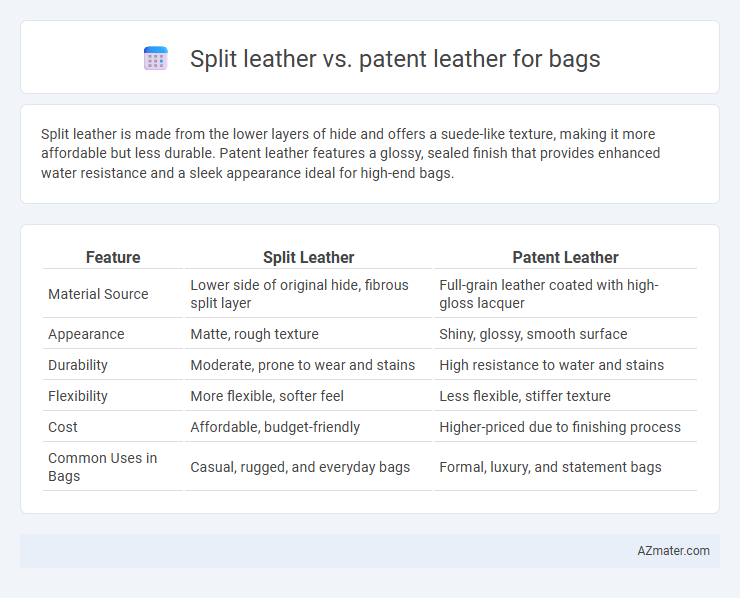Split leather is made from the lower layers of hide and offers a suede-like texture, making it more affordable but less durable. Patent leather features a glossy, sealed finish that provides enhanced water resistance and a sleek appearance ideal for high-end bags.
Table of Comparison
| Feature | Split Leather | Patent Leather |
|---|---|---|
| Material Source | Lower side of original hide, fibrous split layer | Full-grain leather coated with high-gloss lacquer |
| Appearance | Matte, rough texture | Shiny, glossy, smooth surface |
| Durability | Moderate, prone to wear and stains | High resistance to water and stains |
| Flexibility | More flexible, softer feel | Less flexible, stiffer texture |
| Cost | Affordable, budget-friendly | Higher-priced due to finishing process |
| Common Uses in Bags | Casual, rugged, and everyday bags | Formal, luxury, and statement bags |
Introduction to Split Leather and Patent Leather
Split leather is derived from the lower layers of a hide after the top grain is separated, offering a softer texture and greater affordability, commonly used in budget-friendly bags. Patent leather features a high-gloss finish achieved through a lacquer or plastic coating on top grain leather, providing durability and a sleek, polished appearance ideal for fashion-forward handbags. Both materials differ significantly in texture, appearance, and maintenance requirements, influencing their suitability for various bag styles and uses.
Key Differences Between Split Leather and Patent Leather
Split leather is made from the lower layers of the hide, offering a more porous and breathable texture that is less durable and prone to wear compared to patent leather. Patent leather features a glossy, high-shine finish achieved through a coating process that makes it more water-resistant and easier to clean, with a smoother and more polished appearance. The key differences lie in durability, texture, and finish, where split leather provides a softer feel but less protection, while patent leather delivers a sleek look with enhanced resistance to moisture and stains.
Durability Comparison: Split Leather vs Patent Leather
Split leather, made from the fibrous layer beneath the top grain, tends to be less durable and more prone to wear and tear compared to patent leather. Patent leather features a high-gloss, coated surface that offers superior resistance to moisture and stains, making it more durable for long-term use in bags. The protective finish on patent leather significantly enhances its lifespan, whereas split leather often requires more maintenance to sustain its appearance.
Visual Appeal: Texture and Shine
Patent leather bags boast a glossy, mirror-like shine that enhances their visual appeal with a smooth, reflective surface ideal for formal occasions. Split leather offers a more textured, matte finish, showcasing natural grain patterns that provide a rugged, casual aesthetic. The choice between patent and split leather affects the bag's overall style, where patent leather delivers high shine and elegance, while split leather emphasizes texture and a subdued luster.
Maintenance and Cleaning Requirements
Split leather bags require gentle cleaning with a damp cloth and mild soap to avoid damage since their porous surface easily absorbs dirt and moisture. Patent leather bags have a glossy, sealed finish that resists stains and water, making them simpler to clean with just a soft, damp cloth and occasional polishing for shine. Proper maintenance involves conditioning split leather to prevent drying and cracking, while patent leather benefits from avoiding abrasion to maintain its reflective surface.
Cost Analysis: Which is More Affordable?
Split leather bags are generally more affordable due to their lower-quality hide layers and less intensive manufacturing compared to patent leather, which involves additional coating processes for its glossy finish. Patent leather tends to be pricier because of its polished, high-shine surface and greater durability, often making it a long-term investment despite the initial cost. For budget-conscious buyers, split leather offers a cost-effective option while patent leather suits those willing to spend more for style and longevity.
Environmental Impact and Sustainability
Split leather is made from the fibrous part of the hide left after the top grain is separated, often treated with synthetic coatings, which raises environmental concerns due to chemical use and lower durability leading to quicker disposal. Patent leather involves applying a high-gloss, plastic coating over the surface, increasing its non-biodegradability and reliance on petroleum-based products, negatively impacting sustainability. Both materials have environmental drawbacks, but split leather's lower quality leads to shorter bag lifespan, while patent leather's plastic finish contributes to microplastic pollution and challenges in recycling.
Popular Uses in Bag Design
Split leather is popular for casual and rugged bag designs due to its textured finish and affordability, often used in tote bags, backpacks, and satchels. Patent leather is favored in luxury and formal bags for its glossy, polished appearance, commonly seen in clutches, evening bags, and high-end purses. Both materials offer distinct aesthetic appeals that cater to different fashion preferences and occasions.
Pros and Cons of Split Leather Bags
Split leather bags offer durability and affordability by utilizing the lower layers of the hide, making them resistant to wear and scratching. However, these bags tend to absorb moisture and stains more easily, requiring protective treatments to maintain appearance and longevity. While split leather bags provide a sturdy option with a rustic texture, they lack the glossy finish and water resistance typical of patent leather.
Pros and Cons of Patent Leather Bags
Patent leather bags boast a glossy, high-shine finish that resists water and stains, making them ideal for formal occasions and easy maintenance. However, this type of leather can be prone to scratches and cracks over time, especially if not stored properly or exposed to extreme temperatures. Unlike split leather, patent leather lacks breathability, which may lead to stiffness and a less natural feel in everyday use.

Infographic: Split leather vs Patent leather for Bag
 azmater.com
azmater.com